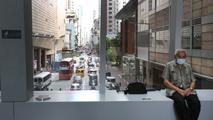 An elderly man donning face mask rests on a bench at Langham Place, Hong Kong, Aug 14, 2020. (PARKER ZHENG/CHINA DAILY)
An elderly man donning face mask rests on a bench at Langham Place, Hong Kong, Aug 14, 2020. (PARKER ZHENG/CHINA DAILY)
HONG KONG - The Hong Kong Special Administrative Region (HKSAR) government announced on Wednesday that its recurrent cash measures lifted 392,900 persons out of poverty and reduced the poverty rate by 5.6 percentage points in 2019.
The HKSAR government released on Wednesday the Hong Kong Poverty Situation Report 2019.
The HKSAR government released on Wednesday the Hong Kong Poverty Situation Report 2019
Adopting the analytical framework of the poverty line (PL) endorsed by Hong Kong's Commission on Poverty, the Office of the Government Economist in collaboration with the Census and Statistics Department (C&SD) updated and analysed the poverty statistics using data from the General Household Survey by the C&SD as the basis. This is the eighth annual update of the poverty situation analysis since the publication of the first official Poverty Line (PL) in 2013.
ALSO READ: Hong Kong’s distorted poverty statistics are misleading
The report showed that after the HKSAR government's recurrent cash intervention, Hong Kong's poverty rate was 15.8 percent and the poor population was 1,097,800 persons in 2019. Before the intervention, the poverty rate and poor population were 21.4 percent and 1,490,700 persons respectively. The recurrent cash measures successfully lifted 392,900 persons out of poverty.
The report said that the Hong Kong economy, hit by a double whammy of local social incidents and China-US trade tensions in 2019, fell into the first recession since 2009. As the local social incidents caused severe disruptions and battered the consumption- and tourism-related sectors that involved substantial lower-skilled jobs, grassroots families were particularly hard-hit.
READ MORE: HK jobless rate drops slightly to 6.3%, pressure remains
All these unfavorable developments, coupled with an accelerated ageing trend and continued dwindling household size, exerted unprecedented upward pressure on the poverty indicators, it added.


